Tube guitar amp using "radio" power transformer
| This DIY guitar amp is the answer to the
design
question: what kind of amp can I build with a power transformer
designed for a one or two-tube radio? The very limited filament
and high voltage current provided by such a transformer rules out
anything like a conventional design. Achieving the final result
took me far away from the familiar territory of 12A_7's, EL84's, and
6V6's
into tubes rarely (if ever) seen in a guitar amp. However, the
sound
produced is both familiar and pleasing - clear and bright tone from
clean
through AD/DC crunch. The ~1W output drives a 1 x 12" speaker
to all the level needed for recording or bedroom practice. It is
loud enough to annoy the family downstairs with all the doors
closed. Construction pictures here. |
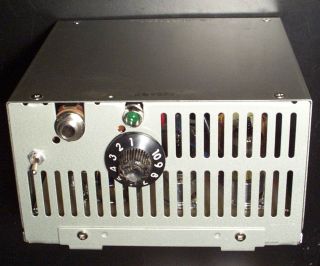 |
Power transformerI picked up this vintage Stancor PS-8415 power transformer new in the box at a hamfest for $2.00 in 2004. It has the following specs:Filament winding.........6.3VAC @ 0.6A High voltage winding....125 VAC. Rated for 15 mA DC with half-wave rectifier. With a full wave bridge rectifier feeding a capacitor input filter, HV output is about 180 VDC with no load. Under load, this will drop to 140 to 160V. The improved efficiency of the bridge rectifier over the half wave rectifier allows us to draw about twice the specified half-wave current, or 30 mA. |
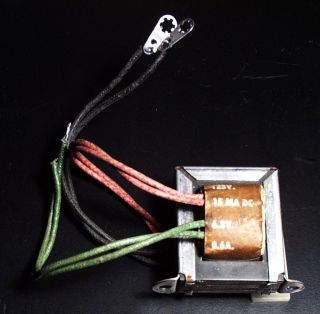 |
An existing low power design option
We know right away that the available filament current limits us to 1
or 2 tubes. For example, two 12A_7's using 300 mA apiece uses the
entire filament budget. Doug Hammond
designed a solution along this line with his Firefly amp.
His Revision
1 creation used the two triodes in a 12AX7 in Marshall-style preamp
to drive a self-split 12AU7 power stage. The only
complication to building this design with the transformer in question
is the need for a 280 VDC B+ voltage. A full wave voltage
doubler power supply arrangement could supply the needed voltage, but
might be marginal for the 25 mA plate current demand.
Since one of my objectives was to learn a little more about vacuum tube
circuits than I would obtain by building Doug's proven design, I
decided Firefly could be Plan B if my own efforts tanked.First original design attempt: TV triode-pentode
My first attempt was for a one-tube solution using a TV
triode-pentode like the 6AW8A.
This tube has been used in audio
applications before. Kazuhiro Sunamura
used one as the audio preamp-poweramp in an amateur radio receiver with
similar B+ voltages, as did the Knight Span-Master
shortwave receiver. Cool386 made an FM radio
(a Fremodyne) using this tube for the audio. These designs
offered workable values for plate, grid, and cathode resistors, and
output transformer impedance. I found that the triode section (mu
= 70) only provided enough gain for a clean tone (it would barely break
up with humbucking pickups), and the pentode output wasn't exciting in
any way. I tried a slightly higher gain triode-pentode, the 6EB8, but
the results were similar, and the 750 mA filament current puts the
circuit slightly over the transformer's spec. In frustration, I
put the prototype on the shelf and built an all-octal tube,
double-power version of the Moonlight in a quest for more clean
headroom.Exploring pentode preamp tubes
Exploring 9-pin mini pentode preamp tubes for the Moonlight
and octal pentode tubes in the Arc
Moonlight projects, I learned that a single pentode stage provides
plenty of gain with a tone quality that reduces the need for a a
gain-sucking tone stack behind it. Mark Lavelle took
the pentode angle quite a ways with his all-6AU6 Pentotron,
a 6AU6
preamp feeding a self-split pair of 6AU6 as the power amp. He
describes the results as "playable, but ripe for some tweaking".
Three 6AU6's drawing 300 mA apiece exceeds my filament budget, but I
thought I'd take a look at the 6AU6 preamp, because I found that its
octal equivalent, the 6SH7,
sounded pretty nice in the Moonlight. In a discussion at AX84, Mark mentioned that 6AU6's (and
other RF pentodes) tended to be microphonic. I had an industrial
version of the 6AU6, the 6136,
designed for shock and vibration resistance. I wired a 7 pin mini
socket into my Moonlight prototype rig and tried it out, with excellent
results. I actually couldn't find any microphonic tendencies in
several regular 6AU6's I also tried. Since I now had a 7 pin
socket in my test rig, I threw several more random RF/IF pentodes into
the circuit to see what would happen. The 6AG5, 6EW6, and 6AK5
all sounded similar (good). Apparently, the plate, cathode, and
screen resistance values in the Moonlight preamp are friendly to just
about any small-signal pentode, which it operates at the lower end of
the possible gain range. The 6AK5 piqued my interest,
both for its tiny bottle (designed for use up to 400 MHz), and the 175
mA filament draw. That would leave a reasonable 425 mA of
filament current for the power tube...Efficient power pentodes with low filament draw
Using Duncan Munro's Tube Data Sheet Locator,
Personal Edition software, I searched for power pentodes requiring
less than 425 mA of 6.3V filament. Interesting candidates found
include the 6K6,
6G6,
and 6AK6.
The 6G6 and its minature
equivalent, the 6AK6, seemed perfect for my purpose, drawing
a minuscule 150 mA filament current and 15 mA plate current with 180V
on the plate. Adam Alpern
used a 6AK6 single-ended in version 1
of his Micro-Champ.
He ended up moving on to the 6AQ5, as his 250
V B+ fried several 6AK6's. As my transformer leaves me with
~160V, this won't be a problem for me. Matti Kari built a
guitar amp with a EF86 preamp and a pair of push-pull 6AK6's driven by
a long tail phase inverter.I was all excited about lashing up a 6AK5 preamp to a 6AK6 power pentode, but unfortunately I didn't have any 6AK6's in my massive trove of random tubes acquired in bulk from a hamfest in summer 2003. But I did find one pretty (but used) 6G6-G in a curvaceous ST envelope, along with a bunch of used 6K6GT's. First I tried the 6K6 (400 mA filament), cathode biased at 330 ohms. Plate voltage was 148V and cathode voltage was 8.0V, giving a plate plus screen current of 24 mA, for a combined dissipation of 3.35W. The tone was a classic bright single-ended pentode that I fell in love with immediately. Next came the 6G6-G. Plate voltage was 158V, and cathode voltage was 6.0V, giving plate plus screen current of 18 mA and a 2.76W combined dissipation. The tone was similar to the 6K6's, but the lower grid bias voltage allows the 6G6 to be driven further into clipping. I am amazed at how much I like the results. The PT gets just nicely warm with the 6G6, and moderately warm with the 6K6 (much cooler than the PT's in my Fender Princeton Reverb and Vibrolux Reverb), so I'm confident that I'm not pushing things at all.
It's likely that I could get away trying a 6V6 or 6AQ5, though the 450 mA filament current puts the PT a little over spec, and the plate current might be pushing it, too. As the plate voltage is about optimal for driving the 6G6 close to its limit, and is pretty easy on the 6K6, I can't see too much advantage to be gained running the 6V6/6AQ5 hungry.
With the 6G6/6AK6, I've got enough filament current to power two of them. I think operating a pair in self-split push pull to increase the power output might draw too much HV current. Using a 6AK6/6G6 as an additional gain stage (biased with a large value cathode resistor to reduce the plate current), it might be possible to get modern high-gain distortion sounds with enough excess gain for a two or thee knob tone stack.
The output transformer for my prototyping is another $1 hamfest special, 3W- 5W sized with a 7K:4 ohm impedance ratio. Figuring 14K into 8 ohms, this is a little higher than the10K ohm load desired by the 6K6 or 6G6, but this just reduces power output by about 20%, and slightly increases distortion. While debugging some oscillation issues (remember, the preamp pentode amplifies beyond 400 MHz) I also tried a massively overrated (for this application) Hammond 125ESE at 10K:8 ohms, with excellent results. For an inexpensive current production transformer, there are several possibilities: Hammond 125H, 125CSE, or 125C. Triode Electronics has a Fender Champ style TF103-48 5K:4/8 ohms that would provide 10K into 8 ohms when an 8 ohm load is connected to the 4 ohm tap. Antique Electronic Supply has the 10K:8 P-T291.
Schematic
The circuit schematic.Construction
One underlying theme of this project is maximum use of recycled materials. The only "retail" parts were rectifier diodes, tube sockets, 6AK6 power pentode, LED, fuse holder, and a coupling cap. Everything else was acquired from hamfests, dumpsters, or the surplus store. The package drove the layout, which differred quite a bit from my usual style. I was pleased at how well everything fit together. Power supply and signal path wiring are incredibly short.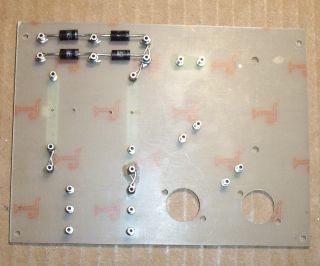 |
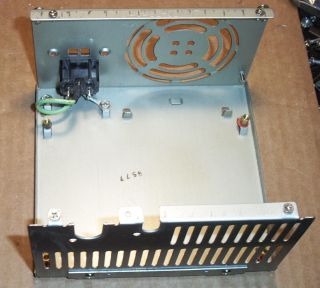 |
| Turret board is built on surplus G10-FR4,
0.0625" thick, copper one side. Diodes for full wave bridge
rectifier are mounted. |
Recycled PC power supply enclosure.
PC motherboard standoffs raise the circuit board for additional
clearance. |
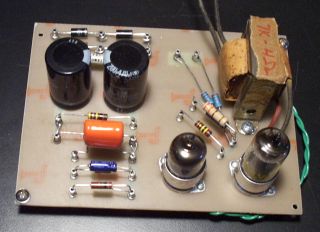 |
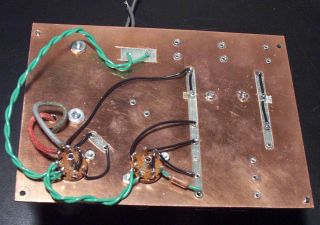 |
| The filter caps were also recycled from PC
power supply: 2 x 470 uF @ 200V. Tubes are located so they can be
easily seen through the front ventilation slots |
To remove the copper where necessary,
score with a utility knife then peel while heating with a soldering
iron. Wiring was remarkably efficient with this layout. |
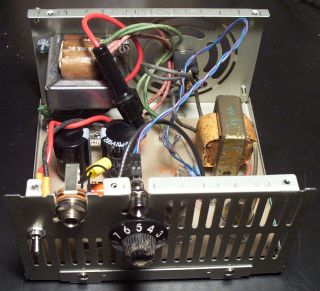 |
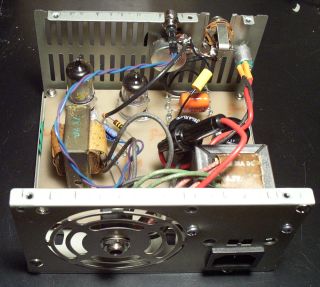 |
| From the front. Slightly melted
volume knob recycled from 1967 Fender Vibrolux. Pilot lamp is
Radio Shack LED and holder above knob. |
From the rear. Speaker jack artfully placed in center of fan cutout. I'll put in a few nylon wire ties when I'm done tweaking. |
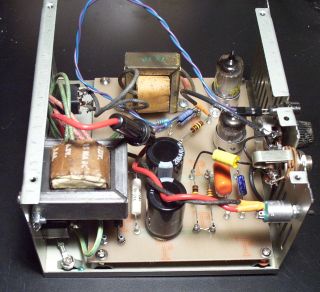 |
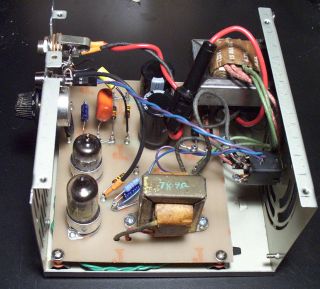 |
| Filament virtual center tap is referenced to power tube cathode. LED uses a secret trick I haven't seen before: Wiring it across one of the 100 ohm filament virtual center tap resistors eliminates need for a separate current limiting resistor. |